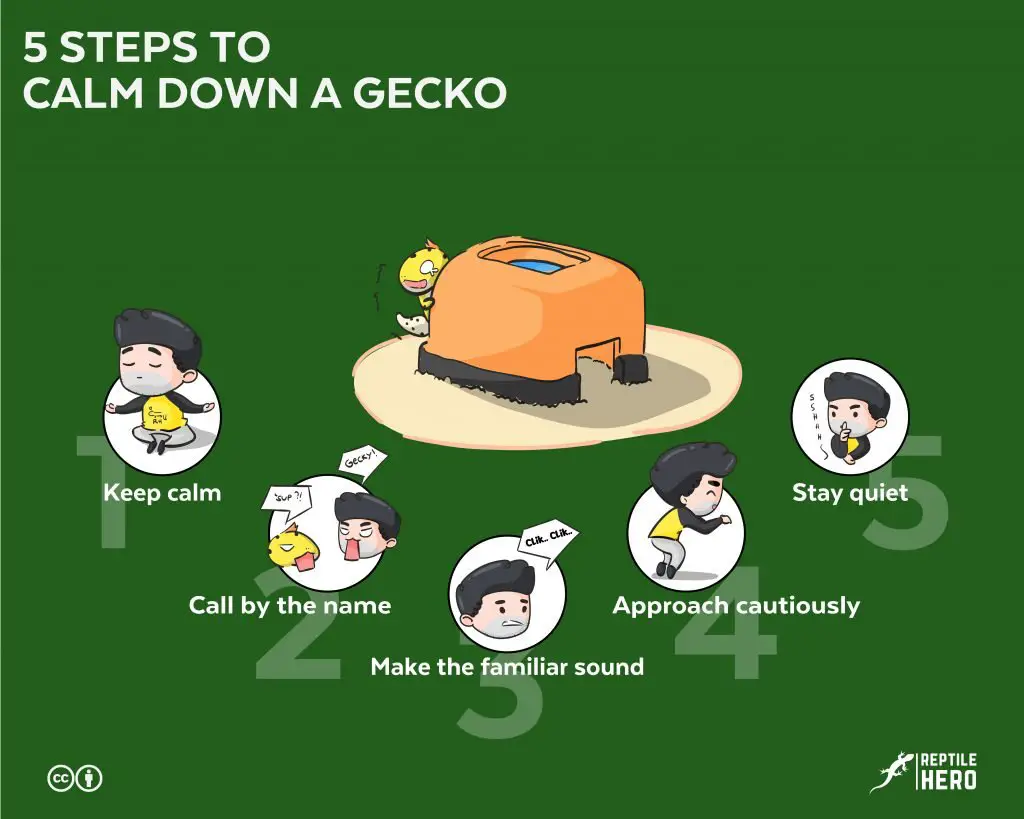5 Steps To Calm Down A Gecko [+4 Simple Tips]
A nervous gecko is something you do not want to encounter every day. But there are unavoidable instances where you might have done something by accident that made your pet insecure or nervous.
Leopard and crested geckos could quickly get nervous when startling situations arise. Here are five steps to follow to calm down a skittish gecko:
- Keep calm
- Call by the name
- Make the familiar sound
- Approach cautiously
- Stay quiet
Keep on scrolling to better handle your dilemma.

How to Calm Down a Gecko in 5 Steps
Out of the geckos I have had, I rarely encounter any of them getting nervous while interacting with them. However, I remember one particular situation when one of them got spooked after I accidentally sneezed. It was an astonishing moment for me, but my gecko did not “Bless me.” Instead, it became nervous.
What are the signs of a nervous gecko?
A nervous gecko will display any one of the following warning signs:
- an agile yet watchful movement
- a tail lifted off of the ground
- a light screech or squeak
- a quick breathing
- a wagging tail
Although I could not stress this enough, I would like to remind you again that leopard and crested geckos rarely bite. However, disregarding the warnings would undoubtedly increase their chance of lashing out at you as a last resort.
Here are the five steps I always do whenever my gecko feels skittish around me.
Step 1: Keep Calm
When whatever instance has pulled the trigger to startle your gecko, you might panic after seeing it move swiftly around the tank for the first time. But you have to keep calm and stay composed wherever you are standing. Your gecko is nervous, and the last thing you want for it is an added stress due to your irrational thinking.
Take a deep breath. Clear your mind. These can help you assess the situation your gecko is in and react to it accordingly. Otherwise, the more panicked you are, the more it would only not be stressful for you but also for your gecko.
For one, your panic-driven decisions could lead to adverse effects on your pet. If it has started running amok, its excessive movement could seriously cause physical injuries. What is worse, your gecko could drop its tail due to the tantamount stress! You totally do not want that to happen, right?
Step 2: Call By The Name
One of the first few things you may do is call your gecko by its name. You may find doing this a little absurd, or you might see yourself going nuts. But I can surely attest that I noticed subtle changes in its body language whenever I call mine with its name, like the slowing down of its rapid breathing.
Say its name gently or other phrases you used to talk with your gecko. I find that the soft voice really helps in my case. At this point, all you should do is speak as pleasant as you can since your goal is to calm—not frighten—it down.
This is likely to happen because it gets used to our voice while feeding it, thus, trusting us.
Step 3: Make The Familiar Sound
Another thing you can do along with calling its name is making the familiar sound. What I did with mine is introduce a “tsk tsk tsk” sound. I am not entirely referring to the sound used to express disappointment, but close to that.
Below, I found this short clip of an Asian House Gecko producing a clicking sound, which closely resembles what I am trying to get at.
The way I see it is that the “tsk tsk tsk” could distract it during stressful situations. It can help recall your gecko that you—its owner whom your pet has associated with positive experiences—are present somewhere.
For example, when I accidentally caught my gecko off guard, it jumped off of my hand and hid at the nearest hide. Though not immediately, I gently produced the familiar sound while alternately calling its name. Slowly, it crept out of hiding after a few moments of trying to comfort it.
Again, this may sound weird, but I have been doing this whenever one of my geckos becomes jittery. And hey, most often than not, I have obtained good results in doing so!
Step 4: Approach Cautiously
It usually takes me roughly 15 minutes of alternately calling its name and making the familiar sound. After that, I would notice that my nervous gecko has loosened up a bit. Though it largely depends on how tensed your gecko might be, it could either last shorter or longer. Nevertheless, you just have to take things cautiously.
Once your pet looks less skittish such as it starts to slowly walk around or breathe normally, you can take this as a cue to slowly approach it. You might want to do this to remove anything that may have startled it, or that could physically injure it.
Again, never move too quickly, make unnecessary arm gestures, or stomp your feet. Also, never do anything unusual like switching the lights or air-conditioning unit on or off. Otherwise, it would freak out your gecko again. Inhale, exhale, and take your time when approaching your gecko.
Step 5: Stay Quiet
Knowing how easily a gecko becomes agitated, you have to be quiet and stay still. Especially at the peak of its spookiness, you should avoid unnecessary noises. Apparently, I am not pertaining to softly calling its name or gently making the familiar sound. Because as much as you can, you have to do both.
Despite keeping yourself quiet, you have to ensure that you make your gecko still feel your presence. And it would best help you calm your gecko down if you eliminate additional stressors.
Do sounds make geckos nervous?
Yes, the following sounds can make a gecko nervous:
- honking car
- banging door
- ringing phone
- mowing lawn
- stomping feet
- conversing people
Hence, be sure to place the gecko tank far from such loud and sudden source noise.

4 Things You Should Not Forget
While you concentrate on following the five steps, you should be mindful that calming down a skittish gecko is on a case-to-case basis. What may have worked well for me may not totally guide you at all. But I have observed in my previous experiences that applying these four reminders has increased my chances of succeeding.
1. Do Not Assume
Let us say that you have sort of finally calmed your gecko down. You are confident that its tail has stopped wagging, gently rested on the ground. Its breathing has somehow normalized, and you observed it walking around the tank.
You are now happy, thinking that you emerge victoriously! But wait, it is too early to assume. As a matter of fact, do not assume that everything is totally okay now. Your gecko may have loosened up a bit after 15 minutes, but the chances of it getting spooked again are still high. If you do anything unusual within the hour or so, you may go back and repeat the calming process again.
2. Should You Handle Your Gecko?
Geckos are pets that do not like to be handled, especially at the peak of its spookiness. Unlike your cats or dogs, leopard and crested geckos are not inherently cuddlers, and you have to accept that.
So, you have to stop yourself from attempting to handle your nervous gecko. You have to appreciate what it is trying to communicate with you. For instance, while a surprising squeak or a wagging tail could be a way of distracting a predator trying to eat it, this could mean to you, “Do not pick me up!” or “Stay away from me!”
Otherwise, you could get a little bite as a result of failing to follow what they have warned you. So, you must respect its behavior and warnings.
3. Should You Leave Your Gecko Alone?
If a gecko is nervous, the owner can quietly sit beside its tank. Occasionally call its name and make that familiar sound gently. Ideally, the gecko should not be left until it has started to calm down.
Okay, so you decided to leave your skittish gecko inside the tank instead. You think it would be better off alone—without your presence—until it has decided to calm down. But even with your good intention, your gecko could misunderstand your action!
If you want to take and carry on the extra mile, you could. The way I see it is that if you were to leave after the startling circumstance, your gecko would confirm that you were the threat. And the way it has responded to you was effective to ward you off. Hence, you have reinforced fear on your gecko.
4. Do Not Rush
I totally understand that you want to end the tedious process as soon as you can. I mean, you were supposed to have fun and enjoy quality time together, right?
But as the old idiom goes, “Haste makes waste.” Rushing into ending the calming process may only worsen your current dilemma. Not only would it waste more time than you should have only taken by proceeding more carefully, but also wasting your effort!
I am pretty sure you want neither from happening and so is your gecko. Thus, you better not rush things. And cautiously take one step at a time to avoid startling your gecko again.

Takeaways
The first step to calm a jittery gecko down is to keep yourself calm. This allows you to think clearly and assess the situation better.
The second step is to call it softly by its name. This is in hopes that your gecko could get distracted by the gentle sound, recalling the positive experiences it connotes your voice with.
The third step is to make the familiar sound. Similar to how calling by its name works, making the familiar sound aims to distract your nervous gecko.
The fourth step is to approach it cautiously. By doing so, you can remove anything that might have startled it, or that could physically injure it.
The last step is to stay quiet. Avoid creating unnecessary noise, but let your gecko still feel your presence around it.


![Got a Gecko With a Bad Stuck Shed? [3 Problems and 9 Solutions]](https://www.reptilehero.com/wp-content/uploads/2021/10/Help-gecko-shed-skin-cc-768x614.jpg)
![Why Does Your Gecko Have Red Eyes? [6 Reasons]](https://www.reptilehero.com/wp-content/uploads/2021/03/Why-gecko-red-eyes-reasons-768x614.jpg)
![How to Choose a Halogen Lamp for Your Leopard Gecko [In-Depth]](https://www.reptilehero.com/wp-content/uploads/2021/07/word-image.jpg)
![5 Causes of Denting on Your Gecko Eggs [and 4 Solutions]](https://www.reptilehero.com/wp-content/uploads/2021/03/G38-768x614.jpg)
![How Fast Does A Gecko Decompose? [4 Factors]](https://www.reptilehero.com/wp-content/uploads/2021/04/How-long-does-it-take-gecko-to-decay-infographic-768x614.jpg)